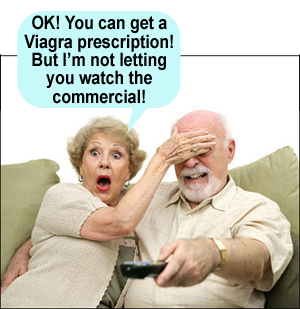Back in December, 2014, I reported in Pharma Marketing News that the FDA was planning to study “Spousal Influence On Consumer Understanding Of And Response To Direct-To-Consumer Prescription Drug Advertisements” (see “Does Your Spouse Influence Your DTC Viewing Experience?“).
At about the same time, the new ad for Viagra, which featured a sexy woman (no man), aired on TV (read “Oh Yeah, Baby! Show Me More!… Viagra TV Ads Like This. But Don’t Let My FDA See It!“).
Of course, I thought the FDA should study how wives (or significant other spousal equivalents) might influence their spouses’ (i.e., husbands’) response to THAT ad.
But, no, the FDA will be using asthma drug ads in their study. Huh?!
It appears that the FDA is using a benign drug category to get results that it may use against Viagra and other male/female enhancement drug ads. AbbVie and Eli Lilly — two marketers of lifestyle-enhancing drugs for men — recognize this ploy and have submitted comments to the FDA in an attempt to shoot down the study.
What’s their beef?
AbbVie, which markets AndroGel testosterone replacement gel, wasted no time beating around the bush in its comments (here):
“It is difficult to ascertain how the Agency will utilize the results of this study should it demonstrate that the perception of ads differs when viewed alone or with someone else. Regulating companion versus solitary viewing practices would present insurmountable legal and practical hurdles. Rather than conduct this study, we suggest that FDA resources and tax payer dollars would be better directed to research that enhances the quality of how we communicate benefit and risk information to consumers regardless of the setting in which the ad is viewed.”
Could it be that AbbVie fears the results of the study will be “utilized” against its AndroGel DTC ads?
Lilly, which markets erectile dysfunction drug Cialis, submitted a similar comment:
“We are challenged to understand how this research yields any useful, actionable information when it is impractical to
influence who is watching TV advertisements at any given time.”
You should know that there are hundreds of product-liability lawsuits against AbbVie and other pharmaceutical companies — including Lilly — over “an aggressive disease-awareness campaign that led millions of men to think that their lack of energy was low-testosterone, or ‘low-T,’ problem. Many men who took AndroGel claim that the drug gave them serious medical problems, including life-threatening cardiac events, strokes and thrombolytic problems” (read this).
FDA had this response to AbbVie’s and Lilly’s comments:
“In regard to prescription drug advertising, it may be that when a risk is perceived as particularly negative, viewing with a partner reinforces this perception. Conversely, it may be that partners downplay risks or emphasize benefits, leading to alternate perceptions and intentions. These potential outcomes have implications for public health. Thus, it is important to generate insight about not only the message portrayed in DTC TV ads but also the conditions under which these messages are received and processed. Pending findings from this research, organizations involved in developing DTC drug communications may be encouraged to remain aware of the social context in which DTC ads are often viewed and the influence of this context on consumer perceptions, judgments, and decisions. Consideration of this broader context may facilitate the development of better DTC drug communications that remain accurate and balanced regardless of setting.”









![6 Digital Tools at the Center of Healthcare Digitalization [INFOGRAPHIC]](http://ec2-54-175-84-28.compute-1.amazonaws.com/pharma-mkting.com/wp-content/uploads/2021/04/6DigitalTools_600px-100x70.jpg)




